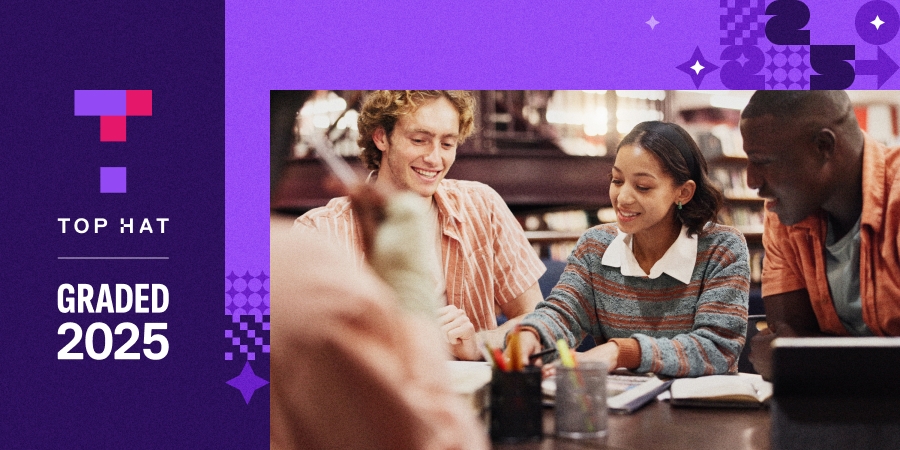Seventy-eight (78) percent of students say online classes are unengaging—and that’s starting to affect their study habits. Many are spending less time completing coursework and others don’t find value in real-time online learning.1 In light of campus closures due to the COVID-19 pandemic, online learning may be the reality for students in the upcoming semester and beyond. Creating experience-driven, customized learning environments can help students see the relevance of course material both online and in-person. For professors, it’s essential to understand how technology can enable meaningful personal contact that humanizes your material and facilitates engaging and experiential learning strategies.
Think back to when you taught classes in person. What worked for you when you had students in front of you? What do you need to do now to create that same experience online? Data-informed, real-time feedback is key for keeping students attentive—even outside of class hours—and helps tailor your instruction to meet their needs. Understanding the importance of a holistic learning experience, facilitating opportunities for students to show what they do—or don’t—know and addressing students’ needs early on are essential for any online class. Top Hat’s new suite of features can easily help you do all that.
A holistic learning experience for everyone
Why it’s important: Content and activities shouldn’t be replicated from your in-person classes—they should be adapted to your virtual classroom. As many professors learn from teaching face-to-face classes, helping students apply material to the real world can make for a more meaningful experience as opposed to imparting knowledge to a passive group of learners. As you would for in-class learning, consider creating a holistic experience online, which involves a mix of theory and practice. Through collaborative exercises or assessments, students are better able to understand the significance of what they’re learning in relation to society at large.
Before class, you may wish to circulate readings or a pre-test to gauge students’ pre-existing knowledge of a topic. Use these insights to inform how you’ll direct your lecture or lab. During class time, you may wish to incorporate discussion questions to see if student understanding of a particular concept has been strengthened or not. In classes that were held on campus, bringing material to life often meant injecting energy—and your own expertise—into course delivery. However, that doesn’t have to suffer online with the range of available tools at your fingertips.
How Top Hat can help: Top Hat’s end-to-end teaching solution can recreate the best in-class experience, online. The Top Hat Catalog is home to custom courseware and question packs, which help extend educational experiences before and after class to create a holistic experience. In-line questions test comprehension along the way, pinpointing the areas you may want to focus on in an upcoming class. Daniel Maxwell, a criminal justice lecturer at the University of New Haven, found Top Hat’s interactive readings facilitated more lively discussions that allowed him to highlight his experience as a law enforcement officer. By regularly gauging students’ comfort with the material before class, he was able to tailor his lectures to meet their needs and in turn, saw a seven percent increase in average quiz scores.
Ample opportunity for students to apply knowledge
Why it’s important: Building in opportunities for regular assessment is a major way professors can build the experience to know which topics may be tricky for learners. It can also help students see how the dots are connected in the learning process. Frequent comprehension checks were always important, but are even more so in an online environment. Weekly low-stakes assessments give professors the opportunity to impart their knowledge more frequently and can help students apply what they know in small portions versus recalling information once or twice per semester on a high-stakes test or exam. Formative assessments like minute papers or case studies can also go beyond the traditional quiz.
How Top Hat can help: Customized homework assignments directly tied to in-class learnings can help students reflect upon material covered during lecture and puts theory into practice. When creating a new assignment, you can harness your knowledge and experience to leverage the most effective questions historically used in your lectures. Auto-graded assessments can also save time in the marking process.
Informal checkpoints, such as questions spread through lectures, can inform what students do and don’t understand. Lecture recordings, accessible after class finishes, are complemented with questions in the same sequence that they appeared live. With Top Hat, you can also effortlessly export grades and participation scores to your LMS.
Identify and address students’ concerns early on
Why it’s important: There is no all-inclusive teaching package that fits everyone’s needs. The best teachers know this from their years of experience. Personalized learning may mean implementing new pedagogical approaches encompassing how, when and through which platforms learning takes place. Students may also be more motivated to continue engaging with material and attending live classes if you’re able to make learnings relevant to all. Informal follow-ups outside of class time can further humanize your course. Twenty-eight (28) percent of students reported difficulty with using online learning tools.1 Customized learning means keeping classes exciting, no matter the makeup of your course. It may also mean adopting technologies that Generation Z is likely already familiar with, such as Tik Tok or other social media platforms which can facilitate gamification.
How Top Hat can help: The best educators understand where students have trouble with course material and immediately troubleshoot. Top Hat’s interactive content strengthens feedback loops between you and your students. Through discussions and interactive textbooks embedded with questions, easily track how specific students perform. The gradebook stores all participation and attendance data, allowing you to quickly sift through this information by student or by question.
A Weekly Course Report sent to your inbox with actionable insights can help determine what question types students struggled with, allowing you to build up that knowledge, experience and familiarity immediately, as well as re-weight questions accordingly. Remember to build new skills and invest in yourself just as much as your students: personalized instructional design help is available with Top Hat Pro. Support is also offered for both students and instructors with Top Hat Basic.
Learn how to turbocharge your online teaching experience with Top Hat’s new feature suite.
References
- Adrift in a Pandemic: 3,000+ Higher Ed Students On Remote Learning and Their Plans for Fall 2020. Top Hat Teaching Resources. https://tophat.com/teaching-resources/ebooks-and-guides/adrift-in-a-pandemic/


